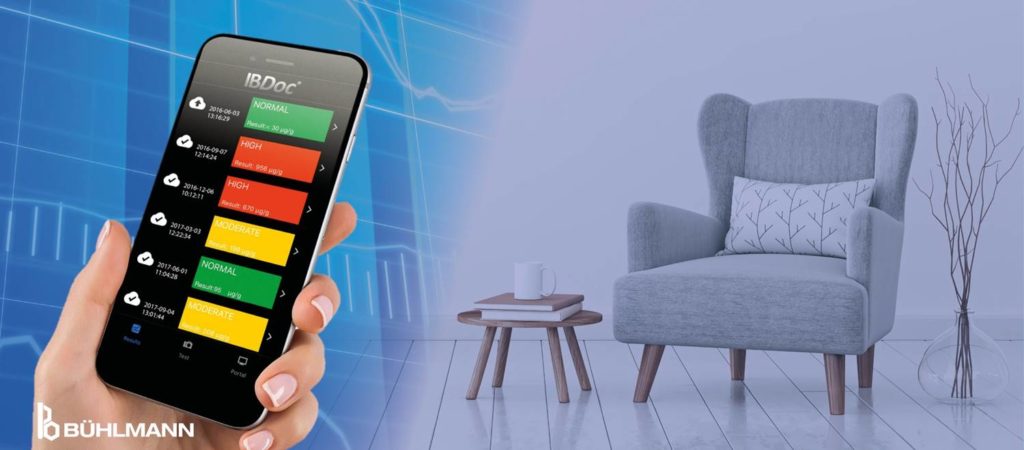The use of fecal calprotectin (fCAL) in clinical routine is demonstrated beyond doubt. We now have extensive knowledge of its efficacy for IBD/IBS differentiation and IBD monitoring, as it has been shown to be an excellent surrogate biomarker for inflammatory status of the gut that correlates well with endoscopic activities (1). The key benefit of measuring fCAL is in avoiding unnecessary endoscopies to patients, which are uncomfortable, painful, time consuming and costly (2).
In 2015, IBDoc® the first home test kit for fCAL obtained the CE marking and took monitoring of IBD patients to a new level. IBDoc® was proven to be as efficient as a lab test (3, 4, 5) and very well accepted by patients in several countries 6, 7, 8. In addition to avoid unnecessary procedures, home testing can avoid hospital visits altogether for the patients. This not only saves time for both, the patients and the healthcare professionals, but also reduces costs. Over the years data on routine usage of IBDoc® has become more and more available. Two posters were recently published at ECCO 2020 and both came to the same conclusion: home testing is perfect to discriminate patients who need immediate care from those who do not (9, 10). As technology continues to improve, patients are now monitored from afar in virtual clinics until they need a physical appointment.
2020 just barely started when a novel event also brought focus on home testing. As the new coronavirus (SARS-CoV-2) continues to spread at an increasing speed, hospitals and whole countries are shutting down to avoid contaminations in an attempt to decrease the numbers of infected people suffering from COVID-19 (11). Early data showed that many of the initially infected people were hospital staff or hospitalized patients (12). Because of this and general social distancing measures, IBD patients are asked to stay at home but it is still recommended that the fCAL monitoring is continued. The European Crohn’s and Colitis Organisation (ECCO) gathered a group of gastroenterologists to address the questions about this global pandemic and to give guidance on how to proceed in this particular situation (13). Additionally, data on IBD patients that have contracted COVID-19 is continually added to the SECURE-IBD registry. The main goal is to prevent patients from going to the hospital, and as a result the priority for the physicians is to set-up virtual clinics to follow their patients from distance. This means frequent phone calls to assess the clinical symptoms, to reduce endoscopic procedures for patients with moderate-to-severe symptoms and to perform fCAL home testing to determine the inflammatory status of the gut. This approach has been assessed and proven to be as efficient as a standard clinical care with hospital appointments (14). The benefits of remote monitoring in the care of patients with chronic diseases for the health care system are obvious and gradually on the way to becoming the new standard of care. The current situation highlights one of the benefits and might help to accelerate the shift to more remote monitoring. Even outside of a pandemic shut-down situation it is a good idea to reduce hospital visits due to potential infection risks. Chronic disease patients are also not always fully mobile and it is not always easy to take time of work to organize hospital travel.
- Rosenfeld, G. et al. FOCUS: Future of fecal calprotectin utility study in inflammatory bowel disease. World J. Gastroenterol. 22, 8211–8218 (2016). http://dx.doi.org/10.3748/wjg.v22.i36.8211
- Yang, Z., Clark, N. & Park, K. T. Effectiveness and cost-effectiveness of measuring fecal calprotectin in diagnosis of inflammatory bowel disease in adults and children. Gastroenterol. Hepatol. 12, 253–62.e2 (2014). http://dx.doi.org/10.1016/j.cgh.2013.06.028
- Ungar B. et. al., 2017, Home smart-phone based measurement of fecal calprotectin by IBD patients: correlation with laboratory assay and applicability as patient-friendly monitoring too, ECCO 2017 Poster.
- Hejl J. et al., 2017, Point of care testing of fecal calprotectin as a substitute for routine laboratory analysis, Practical Laboratory Medicine.
- Heida A. et al., 2017, Agreement Between Home-based Measurement of Stool Calprotectin and ELISA Results for Monitoring Inflammatory Bowel Disease Activity, Clin Gastroenterology and Hepatology.
- Bello C. et al., 2017, Usability of a home-based test for the measurement of fecal calprotectin in asymptomatic IBD patients, Digestive and Liver Disease, 2017.
- Wei S. et al., 2018, Experience of patients with inflammatory bowel disease in using a home fecal calprotectin test as an objective reported outcome for self-monitoring, Intestinal Research.
- Moore AC. et al., 2018, IBDoc® Canadian User Performance Evaluation, Inflammatory Bowel Diseases.
- Avery P. et al., 2020, IBDoc® Faecal calprotectin self-test retrospective audit in a District General Hospital (DGH), ECCO 2020 Poster.
- Sugrue K. et al., 2020, An evaluation of the impact of IBDoc® in clinical practice 5 years after introduction, ECCO 2020 Poster.
- Huang C. et al., 2020, Clinical features of patients infected with 2019 novel coronavirus in Wuhan, China, The Lancet.
- Wang D. et al., 2020, Clinical Characteristics of 138 Hospitalized Patients With 2019 Novel Coronavirus–Infected Pneumonia in Wuhan, China, JAMA
- COVID-19 ECCO Taskforce, published March 20, 2020
- McCombie et al., 2019, A Noninferiority Randomized Clinical Trial of the Use of the Smartphone-Based Health Applications IBDsmart and IBDoc in the Care of Inflammatory Bowel Disease Patients, Inflammatory Bowel Disease, 2019
